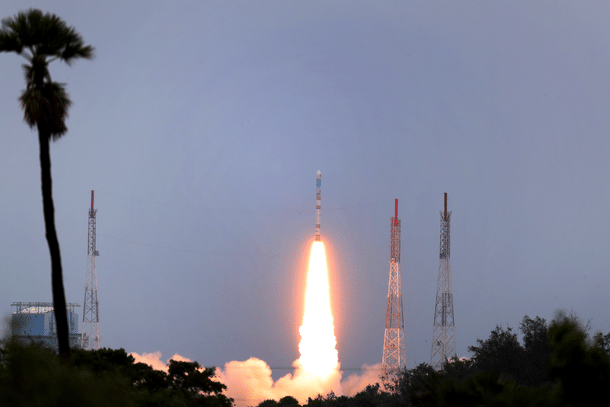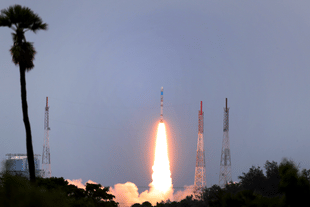Science
“Anomaly In The Placement Of Satellites” — ISRO’s Debut SSLV Mission Comes Up Short
Karan Kamble
Aug 07, 2022, 11:33 PM | Updated 11:33 PM IST
Save & read from anywhere!
Bookmark stories for easy access on any device or the Swarajya app.


We got a rather quick diagnosis for the milestone space mission, featuring India's new launcher, executed improperly today (7 August).
“The satellites were placed in a elliptical orbit in place of a circular orbit,” Indian Space Research Organisation (ISRO) chairman S Somanath said in a statement hours after the SSLV-D1/EOS-02 Mission didn’t meet with complete success.
The Indian space agency launched its maiden indigenous small satellite launch vehicle (SSLV), with which went an Earth-observation satellite and a student satellite, into space from the spaceport in Sriharikota at 9:18 am Sunday morning (Indian Standard Time).
The SSLV carried the 135 kg Earth Observation Satellite (EOS) 02 and the 7.3 kg nano satellite AzaadiSAT, the latter developed by the student team of the startup Space Kidz India.
The EOS-02 was an experimental optical remote sensing satellite with a high spatial resolution for application in areas like agriculture, forestry, geology, and hydrology.
AzaadiSAT, a tribute to India’s celebration of ‘Azaadi ka Amrit Mahotsav’, was a cubesat weighing around 8 kg. It comprised 75 different payloads each weighing around 50 g, built by girl students from across India’s rural regions.
The rocket took off on schedule and all the stages were completed successfully before trouble struck in the last step.
A tweet from ISRO said: “SSLV-D1/EOS-02 Mission: Maiden flight of SSLV is completed. All stages performed as expected. Data loss is observed during the terminal stage. It is being analysed. Will be updated soon.”
“The 356 km circular orbit was our intended orbit, but it (the launch vehicle) could place the satellite in an orbit of 356 x 76 km,” Somanath said later in his video statement.
The unfortunate result of the improper orbit is that the satellites will “come down” due to “atmospheric drag.”
“The satellites have already come down from that orbit and they are no longer usable,” the ISRO chief said.
The issue with the SSLV has been “reasonably identified,” but ISRO plans to “go deeper into it.”
Briefly describing the issue, Somanath said, “It is primarily due to one of logic that exist (sic) in the rocket to identify a sensor failure and go for a salvage option. That means the system has a deficiency which we need to look at very carefully and correct it with regard to a sensor isolation principle.”
“But for that problem, we could not see any other anomaly,” he added.
The ISRO chief is “very happy” with all the various technologies that were put to work and proven for the first time as part of the SSLV mission.
As for the problem, a team of experts has already gotten to work on better understanding the specific issue and why the satellites were placed in the wrong orbit. The team will present recommendations that are expected to be implemented quickly.
“We hope that with the small corrections and further revalidation of those corrections through adequate number of tests, we will come back for launch for the next development flight of SSLV, SSLV-D2, very soon,” Somanath said, expressing hope that they will be “completely successful in proving the vehicle to place satellites in the intended orbit for our commercial use for India and the whole world” in the next attempt.
The SSLV has company — the debut PSLV flight too had suffered a setback in September 1993. The former will do well to replicate the success of what eventually became the ISRO workhorse.
There’s a handsome demand among developing countries, private corporations, and educational institutions for the launch of small satellites, weighing up to 500 kg, into 500 km low-Earth orbit (LEO). The SSLV will be used to deploy small satellites — the whole span, from 10 kg to 500 kg — in LEO.
Larger launch vehicles, like the PSLV, were not able to provide the kind of cost-effective and flexible launch solutions required by smaller players. The SSLV will offer low turnaround time, flexibility in accommodating multiple satellites, launch-on-demand feasibility, and minimal launch infrastructure requirements.
The SSLV is 34 metres tall, about 10 metres less than the PSLV. The diameter of the SSLV, at 2 metres, is also lower than the 2.8 metres of the PSLV. In addition, there’s a 200 tonne difference in lift-off mass between the SSLV (120 tonnes) and PSLV (320 tonnes).
The SSLV is a three-stage vehicle. Whereas solid fuel fires its first three stages (87 t, 7.7 t, and 4.5 t), satellite insertion into the intended orbit is achieved through a liquid propulsion-based velocity trimming module as the terminal stage.
The SSLV is slated to become the next ISRO workhorse, playing a key role in the commercial small satellite launch services.




